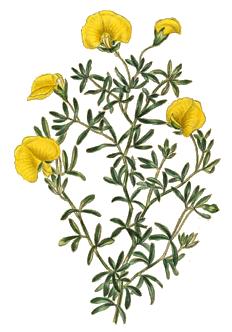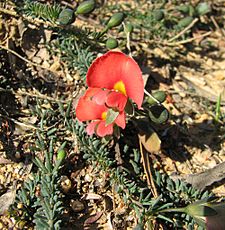Glory peas facts for kids
Quick facts for kids Glory peas |
|
|---|---|
 |
|
| Gompholobium virgatum | |
| Scientific classification | |
| Kingdom: | |
| (unranked): | |
| (unranked): | |
| (unranked): | |
| Order: | |
| Family: | |
| Subfamily: | |
| (unranked): | |
| Genus: |
Gompholobium
Sm.
|
| Type species | |
| Gompholobium grandiflorum Sm.
|
|
| Species | |
|
See text. |
|
| Synonyms | |
|
|
Gompholobium, commonly known as glory peas or wedge-peas, is a genus of plants in the pea family, Fabaceae and is endemic to Australia. Most species have compound leaves composed of three leaflets and all have ten stamens which are free from each other and a distinctive arrangement of their sepals.
Contents
Description
Plants in the genus Gompholobium mostly have leaves composed of three separate leaflets but some species have simple leaves and others have pinnate leaves. The leaflets are arranged alternately along the stems and are usually narrow and have smooth edges. The flowers are usually arranged in groups on the ends of the branches, sometimes singly or in pairs. The sepals form a short tube with five lobes longer than the tube. The large "standard" petal at the back of the flower is circular to kidney-shaped and is larger than the other petals. There are ten free stamens and the ovary is glabrous. The fruit is an oblong to almost spherical legume containing two to many ovules.
Taxonomy and naming
The genus Gompholobium was first formally described in 1798 by James Edward Smith and the description was published in Transactions of the Linnean Society of London. In 2008, Gompholobium grandiflorum was designated the lectotype. The genus name is derived from the Ancient Greek words gomphos, meaning "bolt", "peg", or "nail" and lobos meaning a "capsule" or "pod" referring to "the inflated shape of the seed pods".
Distribution
Glory peas are found in all states of Australia.
Species
Gompholobium comprises the following species:
- Gompholobium aristatum Benth.
- Gompholobium aristatum Benth.
- var. asperulum (S.Moore) Crisp
- var. muticum (Meisn.) Benth.
- Gompholobium baxteri Benth.
- Gompholobium burtonioides Meisn.
- Gompholobium capitatum A.Cunn.
- Gompholobium confertum (DC.) Crisp
- Gompholobium ecostatum Kuchel—Dwarf wedge-pea
- Gompholobium foliolosum Benth.
- Gompholobium glabratum DC.
- Gompholobium gompholobioides (F.Muell.) Crisp
- Gompholobium grandiflorum Sm.
- Gompholobium hendersonii Paxton
- Gompholobium huegelii Benth.—Common wedge-pea
- Gompholobium inconspicuum Crisp—Creeping wedge-pea
- Gompholobium knightianum Lindl.
- Gompholobium latifolium Sm.—Giant wedge-pea
- Gompholobium marginatum R.Br.
- Gompholobium minus Sm.
- Gompholobium nitidum Benth.
- Gompholobium obcordatum Turcz.
- Gompholobium oreophilum C.F.Wilkins & Trudgen
- Gompholobium ovatum Meisn.
- Gompholobium pinnatum Sm.
- Gompholobium polymorphum R.Br.
- Gompholobium polyzygum F.Muell.
- Gompholobium preissii Meisn.
- Gompholobium scabrum Sm.
- Gompholobium shuttleworthii Meisn.
- Gompholobium simplicifolium (F.Muell. & Tate) Crisp
- Gompholobium subulatum Benth.
- Gompholobium tomentosum Labill.
- Gompholobium uncinatum Benth.
- Gompholobium venustum R.Br.
- Gompholobium villosum (Meisn.) Crisp
- Gompholobium virgatum DC.
- var. aspalathoides (Benth.) Benth.
- var. emarginatum (A. Cunn. ex Benth.) F.M. Bailey
- var. virgatum DC.
- Gompholobium viscidulum Meisn.
Species names with uncertain taxonomic status
The status of the following species is unresolved:
- Gompholobium aciculare Rchb.
- Gompholobium amplexicaule Meisn.
- Gompholobium aristatum var. laxum Benth.
- Gompholobium asperulum (S. Moore) Crisp
- Gompholobium barbigerum DC.
- Gompholobium cinereum Chappill
- Gompholobium cyaninum Chappill
- Gompholobium ellipticum Labill.
- Gompholobium ericaefolium A. Cunn. ex Benth.
- Gompholobium ericifolium A.Cunn. ex Benth.
- Gompholobium fimbriatum Sm.
- Gompholobium furcellatum Bonpl.
- Gompholobium gairdnerianum Chappill
- Gompholobium glaucescens A.Cunn.
- Gompholobium glutinosum Chappill
- Gompholobium heterophyllum A.Cunn. ex G.Don
- Gompholobium hirsutum Paxton
- Gompholobium karijini Chappill
- Gompholobium lanatum A.Cunn. ex G.Don
- Gompholobium laxum (Benth.) Chappill
- Gompholobium maculatum Andrews
- Gompholobium muticum (Benth.) Chappill
- Gompholobium pedunculare DC.
- Gompholobium pedunculare Lodd.
- Gompholobium psoraleaefolium Salisb.
- Gompholobium pungens Chappill
- Gompholobium roseum Chappill
- Gompholobium setifolium Sieber ex Benth.
- Gompholobium sparsum A.Cunn. ex Benth.
- Gompholobium stenophyllum F.Muell.
- Gompholobium tenue Lindl.
- Gompholobium tetrathecoides Sieber ex DC.
- Gompholobium venulosum Lindl.
- Gompholobium versicolor Lindl.
- Gompholobium wonganense Chappill
Ecology
Toxicity of plants of the genus was suspected and proven to be fatal to sheep, goats and other livestock introduced by the pastoralists at the Swan River Colony. This was reported by James Drummond in Hooker's London journal of botany 1842.


